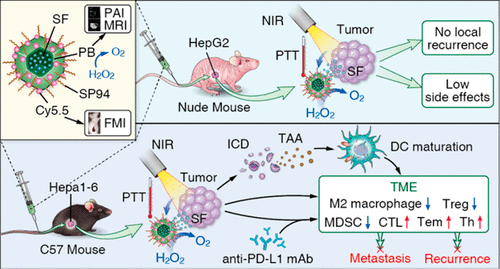Our official English website, www.x-mol.net, welcomes your feedback! (Note: you will need to create a separate account there.)
A Hepatocellular Carcinoma Targeting Nanostrategy with Hypoxia-Ameliorating and Photothermal Abilities that, Combined with Immunotherapy, Inhibits Metastasis and Recurrence.
ACS Nano ( IF 17.1 ) Pub Date : 2020-09-10 , DOI: 10.1021/acsnano.0c01453 Tianjun Zhou 1, 2, 3 , Xiaolong Liang 4 , Peifeng Wang 1, 2, 3 , Yueyang Hu 1, 2, 3 , Yafei Qi 2 , Yushen Jin 5 , Yang Du 2, 6 , Chihua Fang 1, 3 , Jie Tian 2, 7
ACS Nano ( IF 17.1 ) Pub Date : 2020-09-10 , DOI: 10.1021/acsnano.0c01453 Tianjun Zhou 1, 2, 3 , Xiaolong Liang 4 , Peifeng Wang 1, 2, 3 , Yueyang Hu 1, 2, 3 , Yafei Qi 2 , Yushen Jin 5 , Yang Du 2, 6 , Chihua Fang 1, 3 , Jie Tian 2, 7
Affiliation

|
Hepatocellular carcinoma (HCC) is a common and highly malignant tumor that is prone to recurrence and metastasis and has no effective treatment. Unsurprisingly, its prognosis is quite poor; early detection methods and effective low-toxicity treatments are urgently needed. To achieve these goals, we designed a multifunctional, U.S. Food and Drug Administration-approved Prussian blue (PB) nanoparticle (NP) with a porous metal organic frame loaded with sorafenib (SF), conjugated with HCC-specific targeting peptide SP94 and the near-infrared dye cyanine (Cy)5.5. These NPs are amenable to multimodal imaging for dynamic monitoring of their biodistribution and tumor-targeting effects. The SP94-PB-SF-Cy5.5 NPs achieved targeted delivery and controlled SF release and exhibited good photothermal effects. In this strategy, photothermal therapy and SF treatment complement each other, reducing the side effects of SF and achieving a therapeutic effect without local tumor recurrence. In addition, the catalase-like ability of the NPs alleviates tumor hypoxia, and their photothermal effects induce immunogenic cell death, leading to the release of tumor-associated antigens. These effects combine to trigger an antitumor immune response; the NPs also displayed promising inhibitory effects on tumor metastasis and recurrence and produced an abscopal effect and long-term immunological memory when combined with antiprogrammed death-ligand 1 (PD-L1) immunotherapy. These safe, multifunctional NPs represent a valuable treatment option for HCC. In addition, this next-generation treatment model may provide some ideas for the management of HCC and other cancers.
中文翻译:

肝细胞癌靶向纳米策略与缺氧改善和光热能力,结合免疫疗法,抑制转移和复发。
肝细胞癌(HCC)是一种常见的高度恶性肿瘤,易于复发和转移,尚无有效的治疗方法。毫不奇怪,它的预后很差。迫切需要早期发现方法和有效的低毒治疗方法。为了实现这些目标,我们设计了一种经过美国食品药品监督管理局批准的多功能普鲁士蓝(PB)纳米颗粒(NP),其多孔金属有机骨架装有索拉非尼(SF),并与HCC特异性靶向肽SP94和附近的化合物偶联-红外染料花青(Cy)5.5。这些NP适用于多模态成像,以动态监测其生物分布和肿瘤靶向作用。SP94-PB-SF-Cy5.5 NP可实现靶向递送并控制SF释放,并表现出良好的光热效应。在这个策略中 光热疗法和SF治疗相辅相成,减少了SF的副作用,并达到了无局部肿瘤复发的治疗效果。另外,NP的过氧化氢酶样能力减轻了肿瘤的缺氧,并且它们的光热效应诱导了免疫原性细胞死亡,导致了肿瘤相关抗原的释放。这些作用共同触发了抗肿瘤免疫反应。当与抗程序死亡配体1(PD-L1)免疫疗法联合使用时,NPs还显示出对肿瘤转移和复发的有希望的抑制作用,并产生了抽象作用和长期的免疫记忆。这些安全,多功能的NP代表了肝癌的宝贵治疗选择。此外,这种下一代治疗模型可能为HCC和其他癌症的治疗提供一些思路。
更新日期:2020-10-28
中文翻译:

肝细胞癌靶向纳米策略与缺氧改善和光热能力,结合免疫疗法,抑制转移和复发。
肝细胞癌(HCC)是一种常见的高度恶性肿瘤,易于复发和转移,尚无有效的治疗方法。毫不奇怪,它的预后很差。迫切需要早期发现方法和有效的低毒治疗方法。为了实现这些目标,我们设计了一种经过美国食品药品监督管理局批准的多功能普鲁士蓝(PB)纳米颗粒(NP),其多孔金属有机骨架装有索拉非尼(SF),并与HCC特异性靶向肽SP94和附近的化合物偶联-红外染料花青(Cy)5.5。这些NP适用于多模态成像,以动态监测其生物分布和肿瘤靶向作用。SP94-PB-SF-Cy5.5 NP可实现靶向递送并控制SF释放,并表现出良好的光热效应。在这个策略中 光热疗法和SF治疗相辅相成,减少了SF的副作用,并达到了无局部肿瘤复发的治疗效果。另外,NP的过氧化氢酶样能力减轻了肿瘤的缺氧,并且它们的光热效应诱导了免疫原性细胞死亡,导致了肿瘤相关抗原的释放。这些作用共同触发了抗肿瘤免疫反应。当与抗程序死亡配体1(PD-L1)免疫疗法联合使用时,NPs还显示出对肿瘤转移和复发的有希望的抑制作用,并产生了抽象作用和长期的免疫记忆。这些安全,多功能的NP代表了肝癌的宝贵治疗选择。此外,这种下一代治疗模型可能为HCC和其他癌症的治疗提供一些思路。



























 京公网安备 11010802027423号
京公网安备 11010802027423号